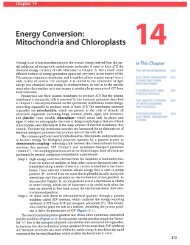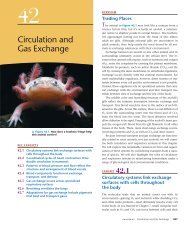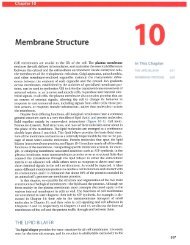Ch05 Molecular Structure and Orbitals.pdf - finedrafts
Ch05 Molecular Structure and Orbitals.pdf - finedrafts
Ch05 Molecular Structure and Orbitals.pdf - finedrafts
Create successful ePaper yourself
Turn your PDF publications into a flip-book with our unique Google optimized e-Paper software.
E<br />
FIGURE 5.34<br />
(a) The MO energy-level diagram for<br />
the H 2 molecule. (b) The shapes of<br />
the MOs are obtained by squaring the<br />
wave functions for MO 1 <strong>and</strong> MO 2. The<br />
positions of the nuclei are indicated<br />
by •.<br />
A<br />
Energy of<br />
an atomic<br />
orbital in a<br />
free atom<br />
Antibonding<br />
MO<br />
Bonding<br />
MO<br />
B<br />
Energy of<br />
an atomic<br />
orbital in a<br />
free atom<br />
FIGURE 5.35<br />
Bonding <strong>and</strong> antibonding molecular<br />
orbitals (MOs).<br />
Bonding will result if the molecule<br />
has lower energy than the separated<br />
atoms.<br />
E<br />
H A<br />
1s A<br />
(a) Energy diagram<br />
H 2<br />
MO 2<br />
MO 1<br />
H B<br />
1s B<br />
5.3 The <strong>Molecular</strong> Orbital Model 219<br />
3. MO 1 is lower in energy than the 1s orbitals of free hydrogen atoms, while MO 2 is<br />
higher in energy than the 1s orbitals. This fact has very important implications for<br />
the stability of the H 2 molecule, since if the two electrons (one from each hydrogen<br />
atom) occupy the lower-energy MO 1, they will have lower energy than they do in the<br />
two separate hydrogen atoms. This situation favors molecule formation, because nature<br />
tends to seek the lowest energy state. That is, the driving force for molecule<br />
formation is that the molecular orbital available to the two electrons has lower energy<br />
than the atomic orbitals these electrons occupy in the separated atoms. This situation<br />
is favorable to bonding, or probonding.<br />
On the other h<strong>and</strong>, if the two electrons were forced to occupy the higher-energy<br />
MO 2, they would be defi nitely antibonding. In this case, these electrons would have<br />
lower energy in the separated atoms than in the molecule, <strong>and</strong> the separated state<br />
would be favored. Of course, since the lower-energy MO 1 is available, the two electrons<br />
occupy that MO <strong>and</strong> the molecule is stable.<br />
We have seen that the molecular orbitals of the hydrogen molecule fall into two<br />
classes: bonding <strong>and</strong> antibonding. A bonding molecular orbital is lower in energy<br />
than the atomic orbitals of which it is composed. Electrons in this type of orbital<br />
will favor the molecule; that is, they will favor bonding. An antibonding molecular<br />
orbital is higher in energy than the atomic orbitals of which it is composed. Electrons<br />
in this type of orbital will favor the separated atoms (they are antibonding). Fig. 5.35<br />
illustrates these ideas.<br />
4. Fig. 5.34 shows that for the bonding molecular orbital in the H 2 molecule the electrons<br />
have the greatest probability of being between the nuclei. This is exactly what we<br />
would expect, since the electrons can lower their energies by being simultaneously<br />
attracted by both nuclei. On the other h<strong>and</strong>, the electron distribution for the antibonding<br />
molecular orbital is such that the electrons are mainly outside the space between<br />
the nuclei. This type of distribution is not expected to provide any bonding force. In<br />
fact, it causes the electrons to be higher in energy than in the separated atoms. Thus<br />
the molecular orbital model produces electron distributions <strong>and</strong> energies that agree<br />
with our basic ideas of bonding. This fact reassures us that the model is physically<br />
reasonable.<br />
5. The labels on molecular orbitals indicate their symmetry (shape), the parent atomic<br />
orbitals, <strong>and</strong> whether they are bonding or antibonding. Antibonding character is indicated<br />
by an asterisk. For the H 2 molecule, both MOs have symmetry, <strong>and</strong> both<br />
are constructed from hydrogen 1s atomic orbitals. The molecular orbitals for H 2 are<br />
therefore labeled as follows:<br />
MO 1 5s 1s<br />
MO 2 5s 1s*<br />
6. <strong>Molecular</strong> electron con gurations can be written in much the same way as atomic<br />
(electron) con gurations. Since the H 2 molecule has two electrons in the 1s molecular<br />
orbital, the electron con guration is 1s 2 .<br />
MO 2<br />
MO 1<br />
(b) Electron probability distribution<br />
Copyright 2010 Cengage Learning. All Rights Reserved. May not be copied, scanned, or duplicated, in whole or in part. Due to electronic rights, some third party content may be suppressed from the eBook <strong>and</strong>/or eChapter(s).<br />
Editorial review has deemed that any suppressed content does not materially affect the overall learning experience. Cengage Learning reserves the right to remove additional content at any time if subsequent rights restrictions require it.






